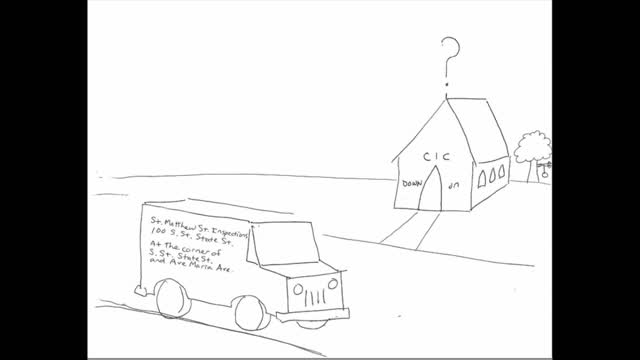Premium Only Content

My Crack Is Showing
As promised by Mr. Cupp in the "Love Cuts Like a Cheese" sketch, here is a word from our sponsor.
This sketch was inspired by a Christian family tree illustration titled, “I am the vine, you are the branches.” Compiled by Reverend Nathan L. Bostian in 2014, the drawing depicts (from, as he notes, an American perspective) how Christianity has “branched out” over the centuries. While John 15:5 does in fact argue that modern Christianity is like a tree with many branches, Matthew might disagree and say that it is more like a foundation with many cracks. When we see words in the illustration like “Great Schism,” we here at CoBaD tend to agree with Matthew.
The title of the sketch was inspired by Cape Breton fiddler Natalie MacMaster’s album “My Roots Are Showing” (2000), which is of course referring to her genealogical roots vice her follicles. We think. In any case, it’s quite a memorable title for an album.
Matthew: "Yep. There’s nothing more destructive to a church’s foundation than acceptance. As the great Roman poet Juvenal once said, 'If you can’t beat them, join them, so they can beat themselves.'”
Refers to line 291 and 292 from Juvenal’s poem “The Satires:”
“Now we suffer the ills of a long peace. Worse for us than war
This luxury’s stifling us, taking its revenge for an empire won.”
Machiavelli (see “The Discourses,” Book II, Chapter XIX) argued that Juvenal is essentially saying in this quote that when the Romans conquered foreign lands, the foreign customs entered the Roman hearts and corrupted their hearts, specifically by replacing frugality with luxury. This was the foreign lands’ way of “avenging the conquered world.”
Essentially, CoBaD is arguing that Romans learned their lesson and let Christianity conquer their land, thereby corrupting Christian hearts with luxury.
Matthew: “Precisely. And it looks like your foundation got even worse after The Great Schism of 1054, splitting it into Orthodox and Roman Catholic factions. And I can tell by the state of your doors that you’ve got Protestant Reformation settling as well. You’ve got a major denomination problem under your feet here.” - Martin Luther allegedly posted his Ninety-five Theses on the door of All Saints' Church in Wittenberg, Germany on 31 October 1517. These theses contained Luther's positions against what he saw as the abuse of the practice of clergy selling indulgences. This was considered to be the beginning of the Protestant Reformation movement.
Matthew: “Yep. For example, I told Edward Mote and William Bradbury about their foundation years ago when I inspected their church, but did they listen to me? No. It wasn’t until 1834 when I threatened to condemn their faith under Chapter 7, versus 24-27 that they came to their senses. They were so impressed, they now regularly sing the praises of having a solid rock foundation.”
Father Garceny: “Yes, I’ve seen them on your commercials. ‘The Solid Rock’ is a catchy jingle.”
Matthew: “Yea, it is. But like I said, you’d better fix this foundation of yours before you end up like them and all Hades breaks loose.”
Refers to Matthew Chapter 7, versus 24-27:
“Therefore everyone who hears these words of mine and puts them into practice is like a wise man who built his house on the rock. The rain came down, the streams rose, and the winds blew and beat against that house; yet it did not fall, because it had its foundation on the rock. But everyone who hears these words of mine and does not put them into practice is like a foolish man who built his house on sand. The rain came down, the streams rose, and the winds blew and beat against that house, and it fell with a great crash.”
The “Solid Rock” jingle refers to the hymn “The Solid Rock.” The lyrics were written by Edward Mote (1797-1874), with music (originally titled “My Hope Is Built on Nothing Less”) by William Batchelder Bradbury (1816-1868).
Father Garceny: “I can’t do that. Our congregation will be up in arms; tonight’s all-you-can-fellowship spaghetti night! What else ya got?” – When we here at CoBaD hear the word “fellowship,” the first words that come to mind are “eat” or “food, “which unfortunately, based on our observations, appears to be quite true. A congregation should be brought together by the body and blood of Christ, not by the bagel and coffee of the donut shop.
Matthew: “You can do a metaphor overhaul, changing from a solid rock architecture to a vine and branch design style you alluded to earlier. That will mean converting your church into a treehouse, though. It will keep your church open. Tell you what, let me talk to John, the Evangelist. Great tree surgeon. Jesus just loves his work. John can be here this afternoon, and have you set up in time for your laity to stuff their faces with fellowship.” – "Jesus just loves his work” refers to the disciple John. John Chapter 20, verse 2: “So [Mary Magdalene] came running to Simon Peter and the other disciple, the one Jesus loved, and said, “They have taken the Lord out of the tomb, and we don’t know where they have put him!”
References:
Bostian, N.L. (2014). “I am the vine, you are the branches.” Jesus in John 15:5. From an American Perspective. (Christian Family Tree).
Juvenal. The Satires. https://web.ics.purdue.edu/~rauhn/Hist_416/hist420/JuvenalSatirespdf.pdf
Machiavelli, N. (1979). The Portable Machiavelli. Ed by Peter Bondanella and Mark Musa. Penguin Books. First published in 1532.
Wikipedia. My Hope is Built on Nothing Less (The Solid Rock). https://en.wikipedia.org/wiki/My_Hope_Is_Built_on_Nothing_Less
Wikipedia. My Roots Are Showing. https://en.wikipedia.org/wiki/My_Roots_Are_Showing
Wikipedia. Ninety-Five Theses. https://en.wikipedia.org/wiki/Ninety-five_Theses
-
 LIVE
LIVE
Major League Fishing
1 day agoLIVE MLF BFL All-American Championship!
3,653 watching -
 LIVE
LIVE
Total Horse Channel
15 hours ago2025 Buckeye Reining Spectacular - Saturday
174 watching -
 LIVE
LIVE
I_Came_With_Fire_Podcast
10 hours agoCIA Spy EXPOSES NSA's Largest DOMESTIC Spy Program EVER
231 watching -
 45:13
45:13
pewculture
16 hours ago $2.32 earnedThe Pew Culture Podcast #17 - Lioness
34.4K2 -
 5:23
5:23
Talk Nerdy Sports - The Ultimate Sports Betting Podcast
4 hours agoMay 30th AI Says LOCK THESE 5 BETS In Today! | Riste Rides Solo While Vasil Road Trips
3.45K1 -
 LIVE
LIVE
The Pete Santilli Show
1 day ago🚨THE PETE SANTILLI SHOW 24/7 FEED 🚨 LIVE SHOWS MON-FRI AT 8-11AM & 4-5PM
425 watching -
 2:43:56
2:43:56
Anthony Rogers
14 hours agoWelcome to Rockville (2025)
3.44K2 -
 15:56
15:56
Damon Imani
20 hours agoDamon VS Everyone on The View | Best Moments Compilation Vol.13
4.05K2 -
 26:00
26:00
ArturRehi
1 day agoFSB Fiasco: Entire Russian Nuclear Program Now public (2 MILLION DOCUMENTS LEAKED) | Ukraine Update
3.76K1 -
 1:42
1:42
Memology 101
14 hours ago $0.49 earnedThis isn't going to end well for Hawaii...
4.63K21